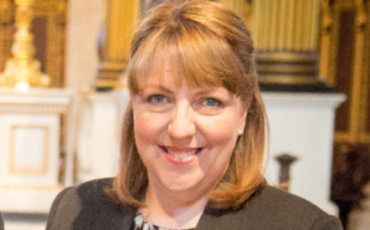St. Paul’s Cathedral is one of London’s most famous landmarks, its majestic dome visible from many parts of the capital. This architectural masterpiece – a symbol of London’s strength and resilience – and has been the site of many historic occasions, including royal weddings and state funerals. It is a working church and a place for quiet reflection, but there are also many wonderful things to see inside on a visit. Blue Badge Tourist guide Patricia Gentry shares just a few of her favourites below.
 St Paul’s Cathedral in London. Photo Credit: © Ursula Petula Barzey.
St Paul’s Cathedral in London. Photo Credit: © Ursula Petula Barzey.
The Geometric Staircase
Featured in the Harry Potter film The Prisoner of Azkaban, this beautiful stone spiral in the cathedral’s southwest tower is known as “The Geometric Staircase”. Keen climbers may want to venture to the top of the church’s famous dome designed by Sir Christopher Wren. It’s not for the fainthearted, but you will be rewarded with breath-taking views of London.
 St Paul’s Cathedral – Geometric staircase. Photo credit: ©Peter Smith, St Paul’s Cathedral.
St Paul’s Cathedral – Geometric staircase. Photo credit: ©Peter Smith, St Paul’s Cathedral.
The Light of the World
St. Paul’s Cathedral has many artworks on display, including some thought-provoking modern art. One of my favourites is “The Light of the World”, a religious painting by William Holman Hunt. Described as “a Christian sermon in a frame”, it was once said to be the most famous painting in the English-speaking world.

The Light of the World. Photo Credit: © Public Domain via Wikimedia Commons.
Hunt was a founding member of the group of artists who called themselves the “Pre-Raphaelite Brotherhood”. They rejected the style of artists who succeeded the High Renaissance painter Raphael, preferring to paint serious subjects straight from nature.
The painting was commissioned by Charles Booth, a wealthy city banker who became a Christian preacher after experiencing a vision. Booth took the painting on a world tour while he preached to millions of people. After travelling for four years, he brought the picture back to England in 1908 and donated it to St. Paul’s Cathedral.
Hunt, by then very old and almost blind, was present at the painting’s installation ceremony at the cathedral, and reportedly wept with joy. He was later buried in the crypt of St. Paul’s, close to the tomb of the cathedral’s architect, Sir Christopher Wren.
There is a lot of symbolism in the painting, so it’s worth taking some time to observe it in detail. At the bottom, the artist added a quote based on a verse from the New Testament: “Behold I stand at the door and knock. If any man hear my voice and opens the door, I will come to him and sup with him and he with me”. The door in the picture, lacking any visible handle, represents the human soul, which can only be opened from the inside. The door is also overgrown with plants, and there are wilted shrubs and rotten fruit on the ground: Sadly, it hasn’t been opened for a long time. Additionally, the lit candle represents Christ, who once said: “I will bring light into your life once the door opens”.
In the mid-1800s, about 50 years before Hunt painted “The Light of the World”, he had made a similar painting for Keble College, Oxford, which still hangs there today. The college charged people to see the painting, which Hunt strongly disapproved of, believing that religious art should be accessible for all.
Statue of John Donne
Tragically, the original medieval St. Paul’s Cathedral burnt down in the Great Fire of London in 1666. This statue of John Donne is the only statue to survive the inferno. It fell through the floor and was covered in rubble, but remained intact. You can still see the scorch marks at its base today.
Who was John Donne? A poet, scholar and member of Parliament for 13 years, and also the dean of St. Paul’s between 1621 and 1631.
Donne was a literary man known for his impressive sermons, and thousands flocked to the cathedral to hear him speak. His style was characterised by abrupt openings, paradoxes and even ironies. He also secretly wrote erotic poems that only circled amongst closed circles of friends.
Toward the end of his life, his preaching became somewhat more sombre and was often about death and the miseries of life. He gave people a positive outlook on death though: “Those who die are sent to Heaven to live eternally”, was his central message. This may be why he chose to be depicted in his statue wearing a death shroud with his eyes closed.
 Memorial to John Donne at St Paul’s Cathedral in London. Photo Credit: © Shakespearesmonkey via Wikimedia Commons.
Memorial to John Donne at St Paul’s Cathedral in London. Photo Credit: © Shakespearesmonkey via Wikimedia Commons.
Tyndale’s New Testament Bible

Portrait of William Tyndale (1836). Photo Credit: © Public Domain via Wikimedia Commons.
Another rare treasure of St. Paul’s Cathedral: the first edition of William Tyndale’s New Testament Bible. This copy of the first Bible ever printed in English is one of just three copies surviving in the world today. It’s the greatest treasure of St Paul’s library collection.
Note: The cathedral library was closed for restoration work at the time of publication.
According to Tyndale, the Church authorities had previously banned translations of the Bible in order “to keep the world still in darkness, to the intent they might sit in the consciences of the people, through vain superstition and false doctrine…and to exalt their own honour…above God himself”.
Inspired to push ahead with the forbidden translations and get the Bible into the hands of the people, Tyndale travelled to Germany – the centre of the Protestant Reformation under Martin Luther – to start printing. Betrayed, he was forced to move on to Worms and from there many copies were smuggled into England.







Leave a Reply